There is more to this than you probably think.
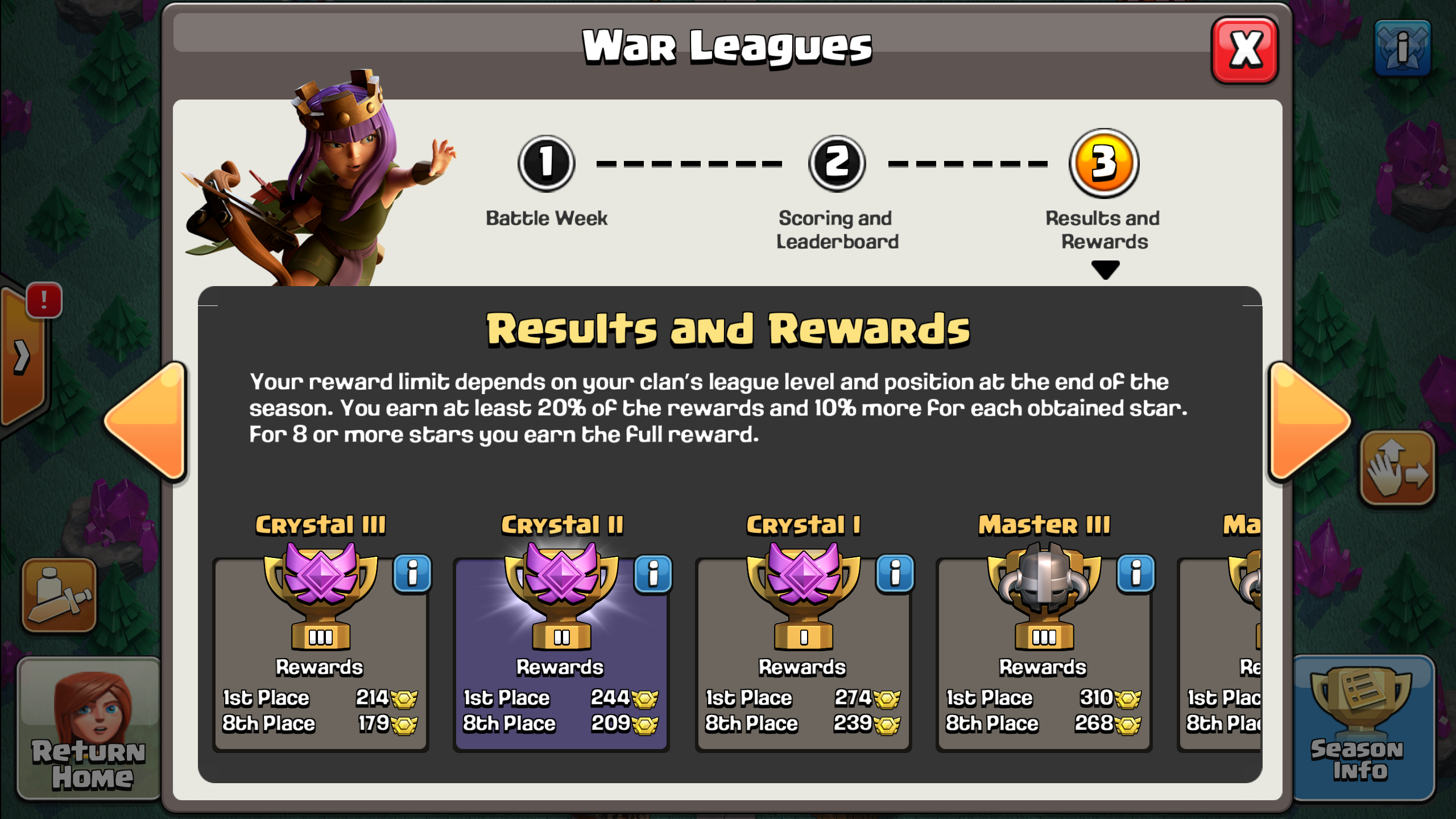 These league points are so good; I?ll rush my base to get high, IDGAF
These league points are so good; I?ll rush my base to get high, IDGAF
Clan War League is easily the most important regularly scheduled F2P event in the game. Success or failure at this highly competitive aspect of Clash of Clans, and proper management of the rewards, can have a big impact on how quickly your base develops. It also happens only once a month, and is misleadingly similar to regular war, often leading whole clans to use misguided strategies that limit their own success!
However, because this is a competition, their mistakes are your clan?s opportunities! In this guide, we will discuss advanced clan-wide strategies to maximize your clan?s overall success. This is not an individual event; sometimes you?ll do things that are individually counter-intuitive for the greater benefit of the team.
Note, this entire guide will be almost useless for clans with every clan member maxed out, but you all are a small minority who already receive the vast majority of guides. Still, there will be a few moderately applicable parts even for your rare situation.
There are a few key factors to consider for CWL: (i) During each war, you only get one attack per player,(ii) Your position is determined across a total of 7 wars with 7 different clans. (iii) Each war win grants a 10 star bonus.(iv) A player needs to earn at least 8 stars to receive the full benefits.(v) Matchmaking only considers how you ranked last month.
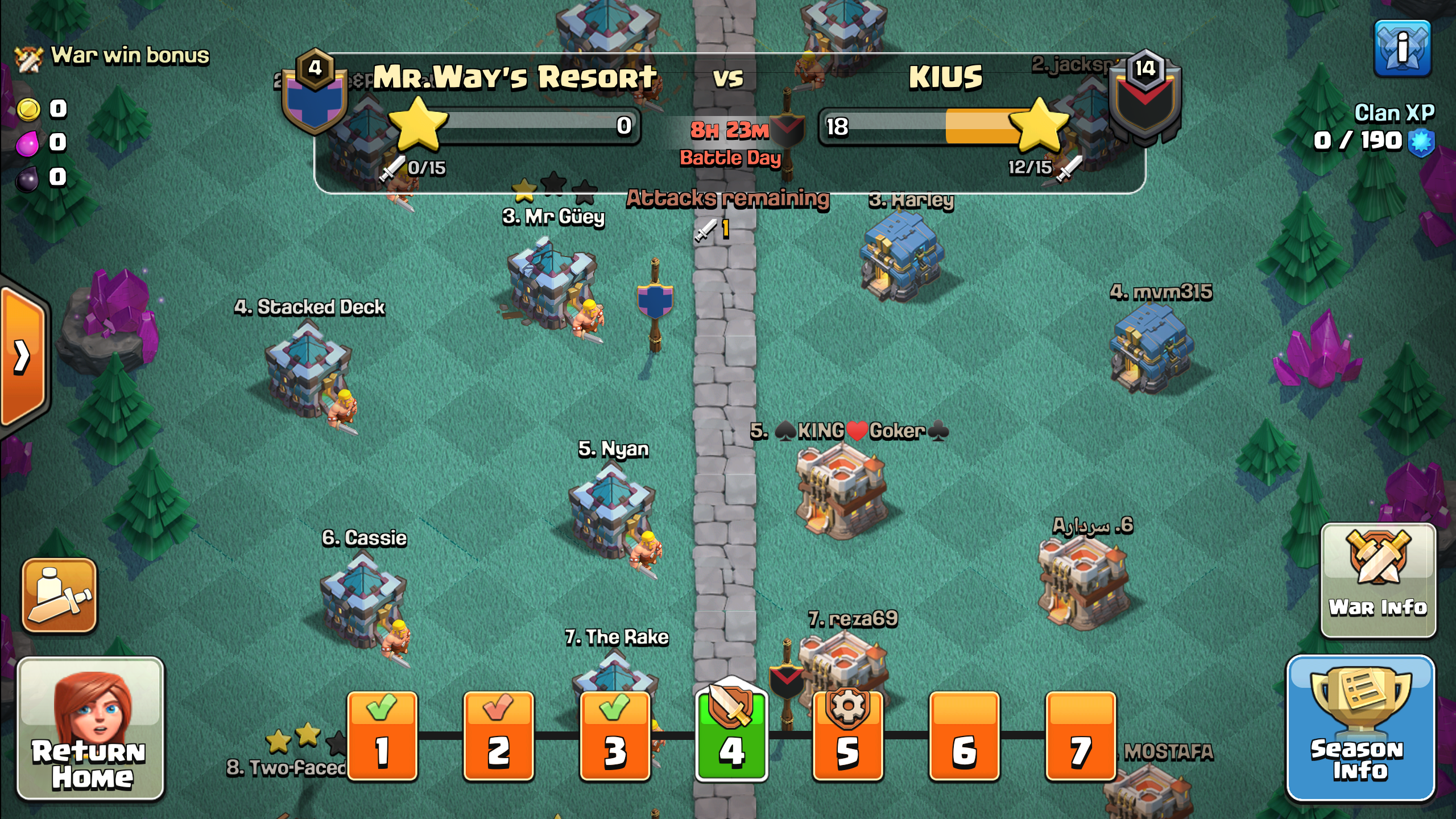 This kind of match-up is not uncommon. We will explore how to take best advantage whichever side you are.
This kind of match-up is not uncommon. We will explore how to take best advantage whichever side you are.
This guide is divided into two sections. The first is pretty straightforward, and describes how to maximize your clan?s probability of advancing leagues.
The second section deals with the optimization problem of maximizing your clan?s total long term league points by balancing your probability of advancing/maintaining leagues vs. including lower power clan members in the roster to get everyone up toward 8 or more stars.
Section 1: Maximizing Your Clan?s Chances For Advancement
Obviously, you need to get the most stars. Sounds simple! It?s not.
 Uh, we?re definitely going to need to get some more stars. That part is undeniably simple.
Uh, we?re definitely going to need to get some more stars. That part is undeniably simple.
The most important peculiarity to recognize is that there is a 10 star bonus for winning a war. This means that in a war that is very close, the winning star is actually worth 11 stars instead of just 1.
Another note: 11 stars is relatively twice as much in 15v15. Coming back from a war loss is easier in 30v30 mode, harder in 15v15.
Why does this matter? Aren?t you always trying to get the winning star? Well, in order to understand the answer to that question, we will first examine the dynamics of choosing how you are going to attack an enemy base. We will use a measurement called ?expected value? and apply it to the collection of war stars. Consider the following:
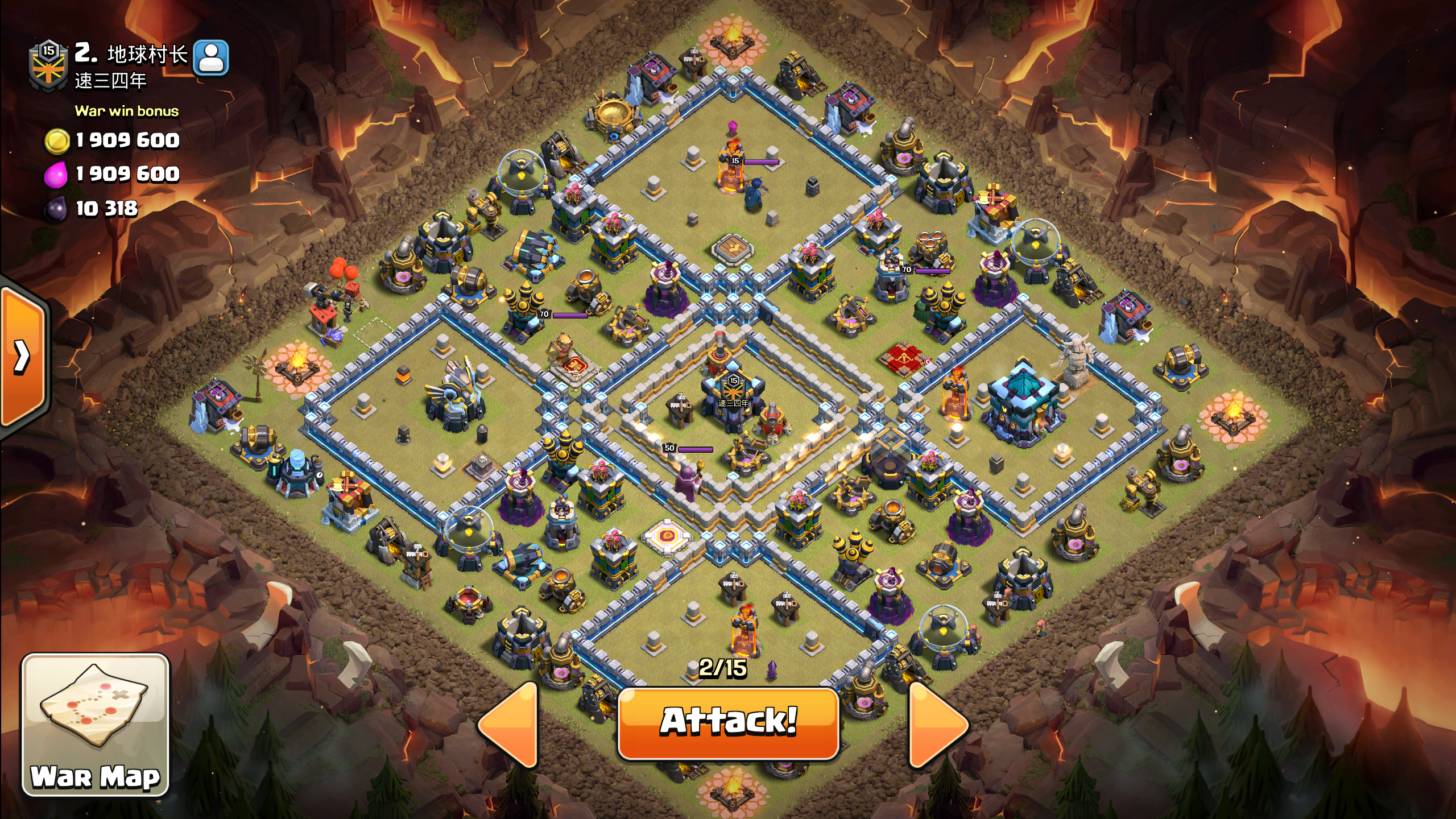 Easy 2-star from the East, but starting from the West has the best (still small) chance for 3-stars.
Easy 2-star from the East, but starting from the West has the best (still small) chance for 3-stars.
As a general point of strategy, your army is the strongest when you first deploy it, and it gets weaker and scattered as you progress through an attack. Even if you save spells for the end, you just won?t have as many units left to boost.
Meanwhile, the eagle artillery is a very powerful defense tower which must not be allowed to fire many times if you are hoping to score 3 stars.
Thus, this kind of base is designed to make it pretty easy to score 2 stars, but especially difficult to win 3 stars; you must choose whether to defeat the eagle artillery quickly or whether to have a large force to guarantee you take down the town hall, or whether to divide your army, weakening the main force.
If you start from the town hall side, you will very likely get exactly 2-stars.However, if you start from the eagle side, there is a better chance you?ll get 3-stars, although also a better chance you?ll get only 1-star.
To calculate the expected value of each way to attack, you need to estimate the chance for each outcome and then take the weighted average stars of those chances. For example, consider:
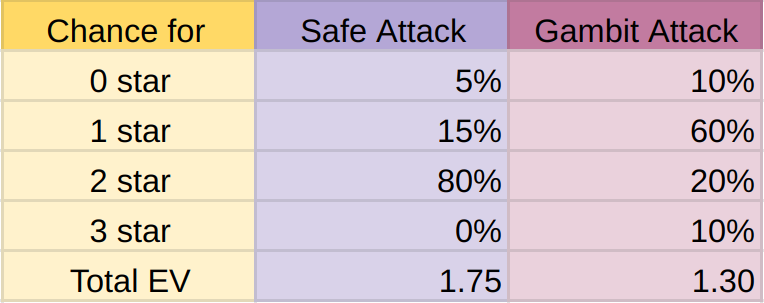 [5(0) + 15(1) + 80(2)]/100 = 1.75; [10*(0) + 60(1) + 20(2) + 10(3)]/100 = 1.30
[5(0) + 15(1) + 80(2)]/100 = 1.75; [10*(0) + 60(1) + 20(2) + 10(3)]/100 = 1.30
A ?safe? attack is one that you expect will not get 3-stars, but it will almost certainly get 2 stars.
A ?gambit? attack is one that you see a small chance that it could get 3 (or 2, much higher) stars, but it could also very easily end up with just 1 star.
These are blurry categories, but they will suffice for this discussion.
There is no way to know for sure what your odds of x-starring are, but practice enough and you?ll get a good idea of what you can realistically accomplish ? and remember, war bases are stronger than normal bases.
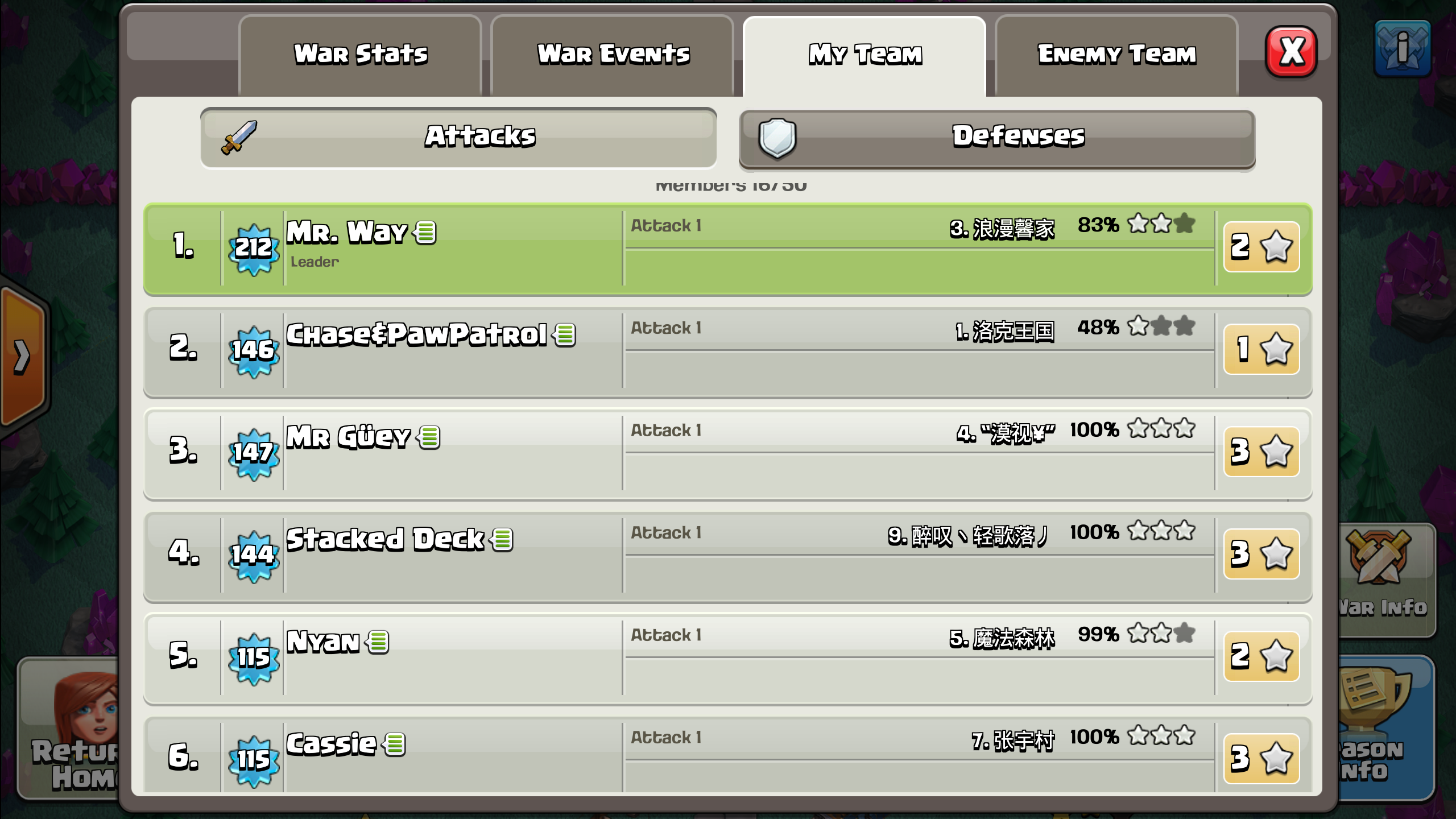

 This is the war I lost. If I had done better target swapping, I probably could have gained at least 5 stars, and won. Those two 99%?s, though; I have to wonder whether I was unlucky or overconfident. More practice will make it clear, but realistic swaps can minimize the effects of either one.
This is the war I lost. If I had done better target swapping, I probably could have gained at least 5 stars, and won. Those two 99%?s, though; I have to wonder whether I was unlucky or overconfident. More practice will make it clear, but realistic swaps can minimize the effects of either one.
If we plug in these probabilities and their values, we end up with the ?safe? attack producing an EV of 1.75 and the ?gambit? attack producing an EV of only 1.3, instead. Clearly, it is better to use a safe attack under these circumstances.
However, we are also faced with the fact that a win contributes an additional 10 stars. If you are in a position where 2 stars is not going to be enough, but 3 stars will push you over the line, then you are looking at this situation instead:
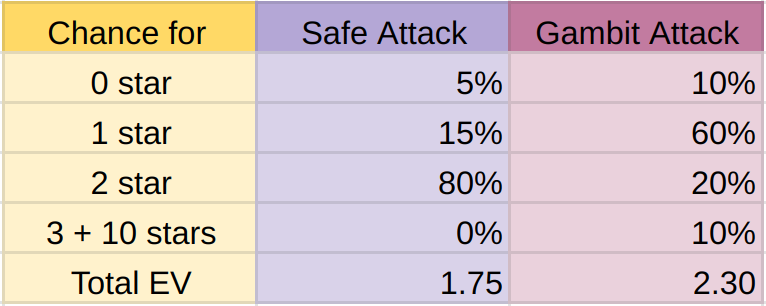 10% chance for 10 more stars adds 10/10 to the EV.
10% chance for 10 more stars adds 10/10 to the EV.
Suddenly, it becomes worth it to gamble for a 3-star attack, even though you will probably fail and get only 1 star, and you could easily have gotten 2-stars!
How will you know when you are potentially talking about the winning star? Every attack counts the same at the beginning or the end, mathematically, so which one is ?the winning? star? The answer is either all of them are or none of them are. If there is no winning star because of a huge mismatch, then everyone should play safe. Otherwise, the losing team should be attempting a lot of gambits.
Here is how you can estimate this even before anybody has attacked.Look through both teams? troop, spell, hero, and defense levels. The way the developers balance the game, they try to make it very challenging but possible to 3-star at your own level, if you both have everything capped out. It is fairly easy to 3-star one level down if you have everything capped out. It is also fairly easy to 2-star one level up if you have everything capped out.
Thus, by comparing each side?s attack and defense potential, we can estimate roughly how many 3-star attacks and how many 2-star attacks they should get. Until we see otherwise, we will assume that they use the best distribution of attacks and get standard results.
By the way, let?s talk about the best distribution of attacks! It?s hard to put into words, so I slapped together this flow chart a while back.
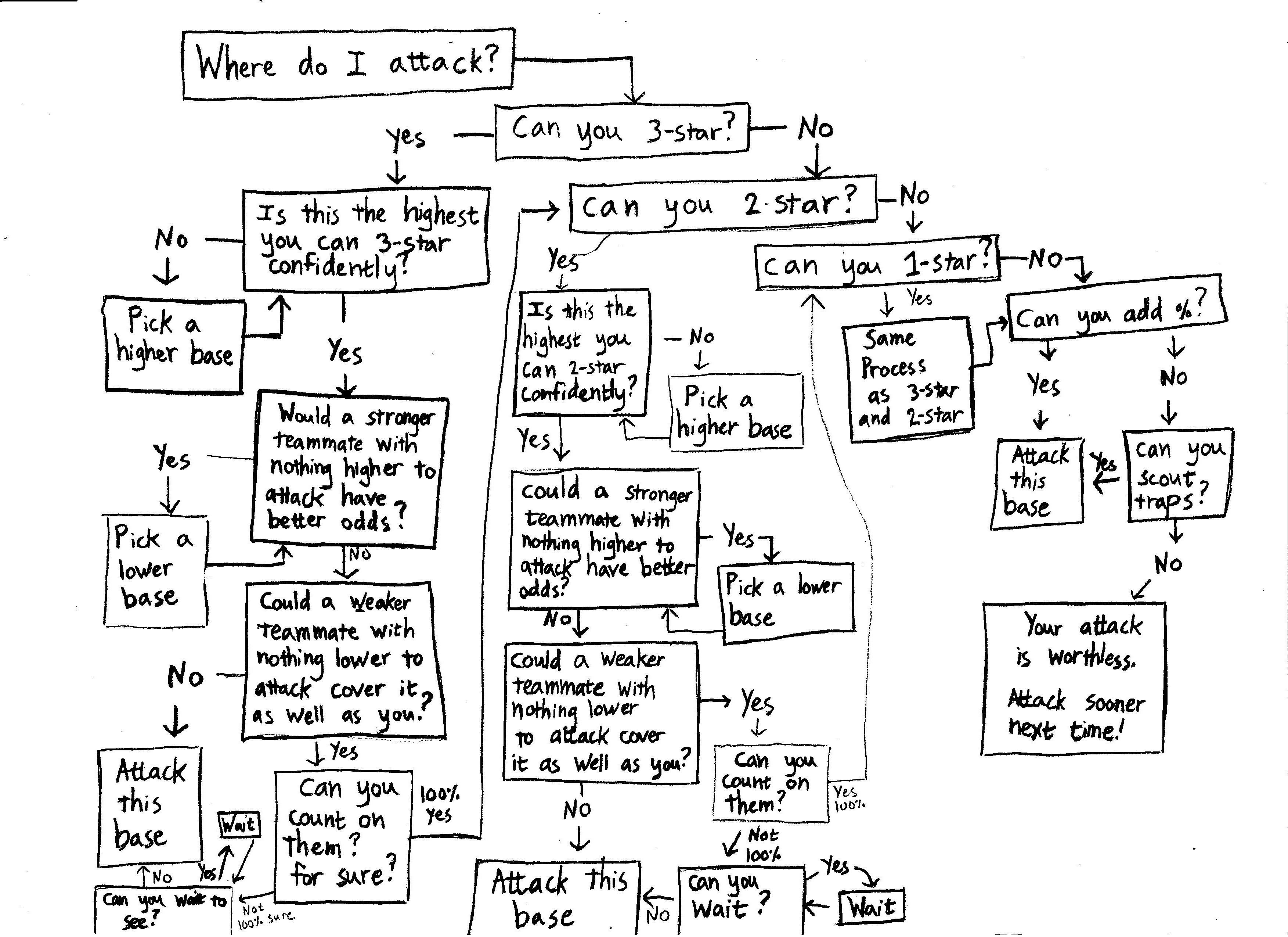 I made this for regular war, but other than ?scout traps? it?s accurate for CWL as well.
I made this for regular war, but other than ?scout traps? it?s accurate for CWL as well.
If your low guys can 3-star anything with over 50% confidence, then that is probably their best target. However, if they are not confident about 3-starring low, they should see how high they can 2-star with confidence, instead. This will free up your higher powered bases to mop up the bottom with ease, at no loss to overall team stars.
Consider two capped out pairs of bases, one TH11 and one TH12 on each team.
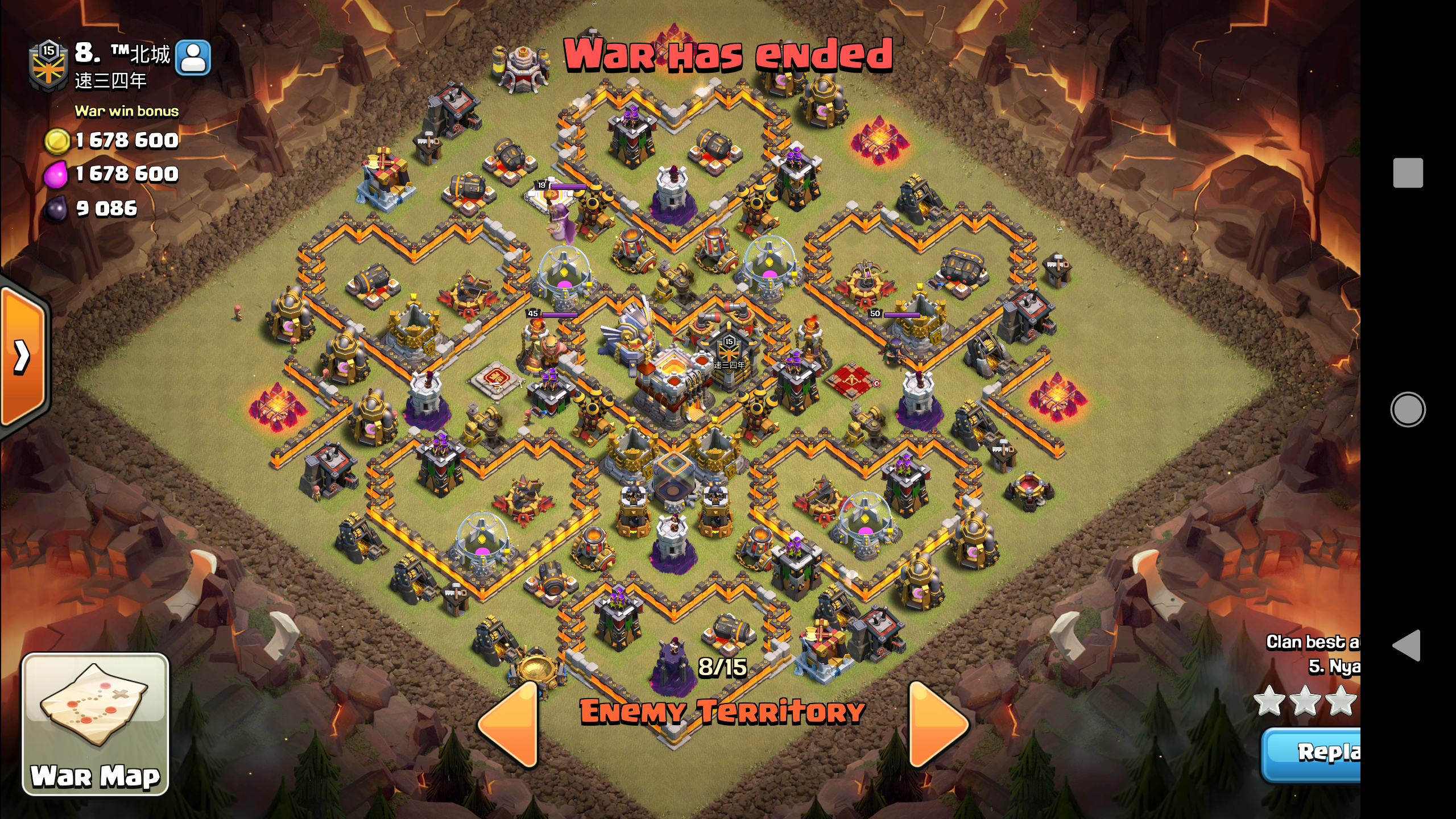
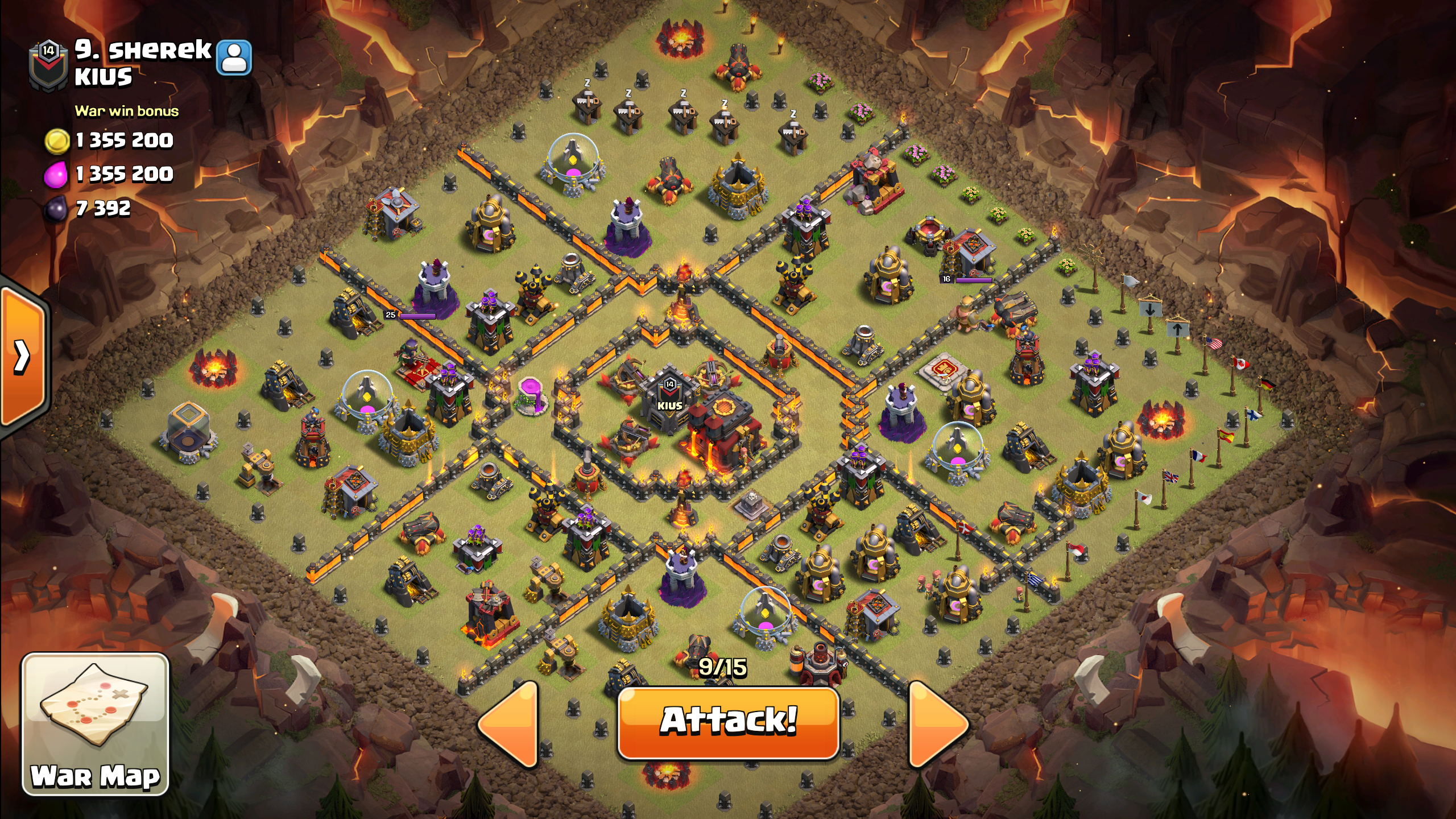 These bases would be challenging to 3-star with a base at their level. However, a decent TH10 could easily 2-star either one! Good swap potential.
These bases would be challenging to 3-star with a base at their level. However, a decent TH10 could easily 2-star either one! Good swap potential.
Your expected value star matrices for these two therefore look like this:
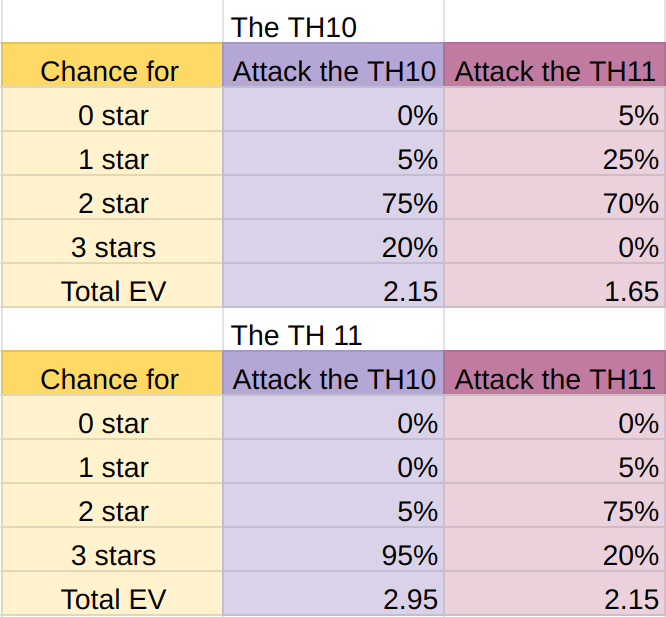 If they swap targets, they have a combined EV of 4.6; if they don?t swap, they have only 4.3
If they swap targets, they have a combined EV of 4.6; if they don?t swap, they have only 4.3
Thus, when choosing your target, you must look to see how many of these swaps would be advantageous for your clan to carry out against that particular enemy clan. It is particularly useful when the enemy has made ?3-proof? bases, which are always easier to 2-star.
There are therefore two kinds of gambits, which may be compounded together: 1) choosing a risky way to attack but with an increased, still-low chance of 3-starring, and 2) also choosing a hard target with a low chance of 3-starring to enable a higher number of 3-stars in total or a much harder target with a low chance of 2-starring, for the same reason. Depending how much of an advantage the enemy has, you may need to consider some real ?Hail Mary? desperate plays with a very low chance of success but very high possible star payouts. Hitting just one big risk as a success early on, like 2-starring their #2 with your #13, lets everyone else attack one level down, increasing your odds for every attack thereafter, compounding the success!
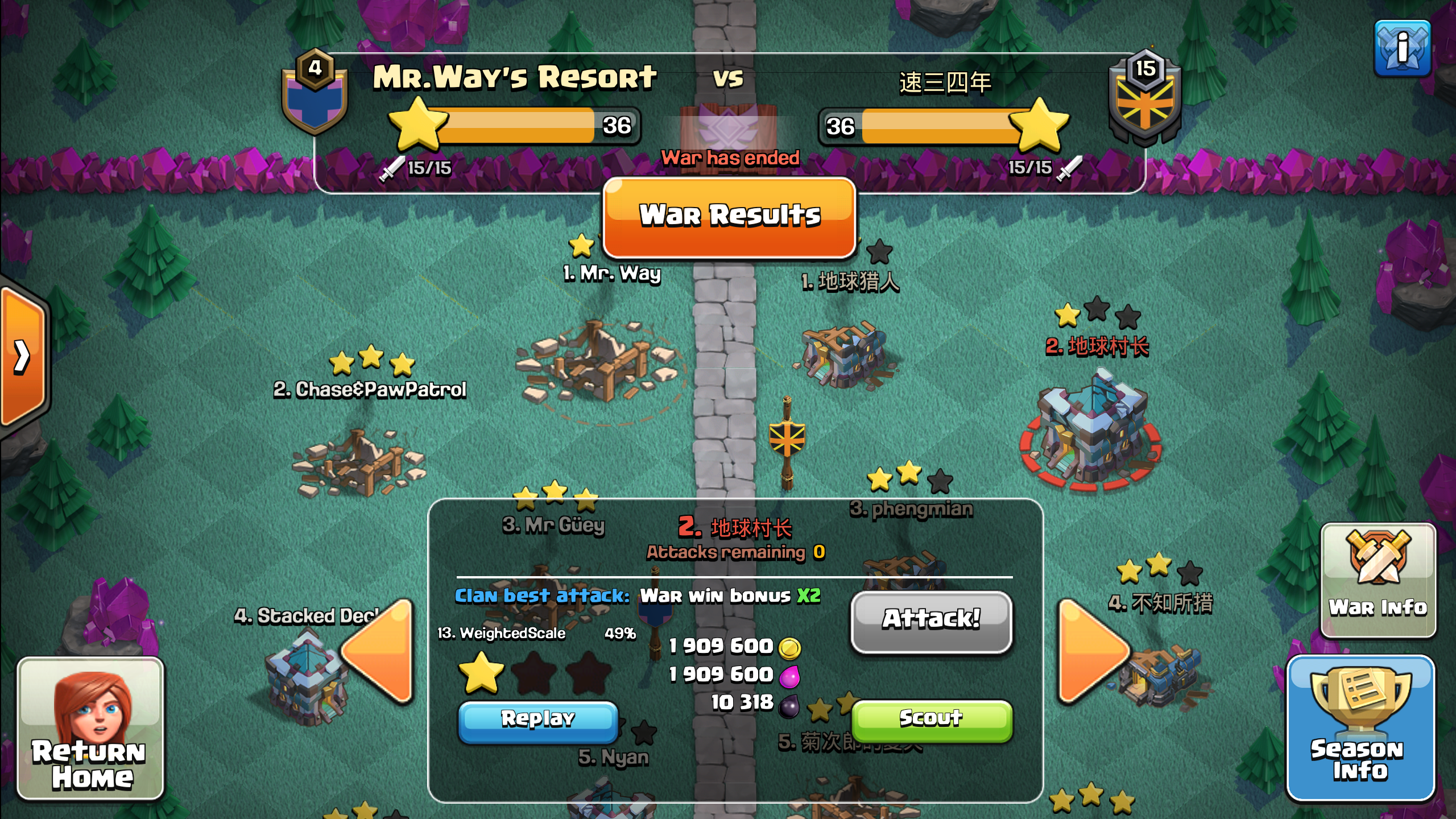 Did not get 2 stars, but the rest of my side was able to attack one level down, and I beat Orange Icon clan! And you?ll have to take my word for this, but if I had used a hero potion, I would have gotten that last 1%.
Did not get 2 stars, but the rest of my side was able to attack one level down, and I beat Orange Icon clan! And you?ll have to take my word for this, but if I had used a hero potion, I would have gotten that last 1%.
Okay, back to finding out about if you need to worry about ?the winning star.? When you look through the enemy team, you will count how many times they can attack one TH level down, and give them an automatic 3-star. For every time they will attack at their level or one level up, you will award them 2 stars. For each that they must attack two levels up, award them 1 star.
Do this for both teams, and see what you expect the final score to be if you both play safe.
Note: You can augment your expected star values further if you know your own clan mates? abilities well. Furthermore, if you are able to infer how good the enemies are at attacking based on their previous match-ups, that should be factored in as well.
There are four main scenarios:
- If your team is expected to win comfortably, then you should play it safe ? unless fortune turns against you and you find yourselves needing to gamble toward the end!
- If it should be very close, you want to wait as long as possible to see how the enemy does in their attacks. If they do better than expected or if they wait as well, you should consider your lowest-risk gambits first.
- If your team is expected to lose by less than 10 stars, you should start with your lowest-risk gambits and proceed through them until you get too many 1-stars and winning becomes completely unrealistic or until you are favored to win when playing safe from there on out.
- If your team is expected to lose by more than 10 stars, you should accept the loss and play as safely as possible from the outset, with no gambling.
 Remember these guys? They should be playing it safe from the start. Guaranteed loss anyway.
Remember these guys? They should be playing it safe from the start. Guaranteed loss anyway.
If you are going to need a lot of gambling, note that swaps should be extreme to create 2-star gambits instead of ?safe? 2-star and ?safe? 3-star attacks. It is possible for a TH10 to 2-star a maxed out TH13, especially if they placed their TH way out on the edge. That, I would not recommend without a lot of practice. But, for a TH11 to 2-star a TH13 is not unreasonable at all!
If your TH11 can jump two levels up, that lets your TH13 and your TH12 both hit one level down. You could easily net 8 stars instead of 6 through this teamwork. If you have several TH11s who can pull this off, your whole TH13 rank may be able to hit only their TH12s, and your TH12s hit only their TH11s! Unless seriously out-leveled, you would be able to sweep everything but the top, very reliably, even if everyone on your team is just a median-skill player!
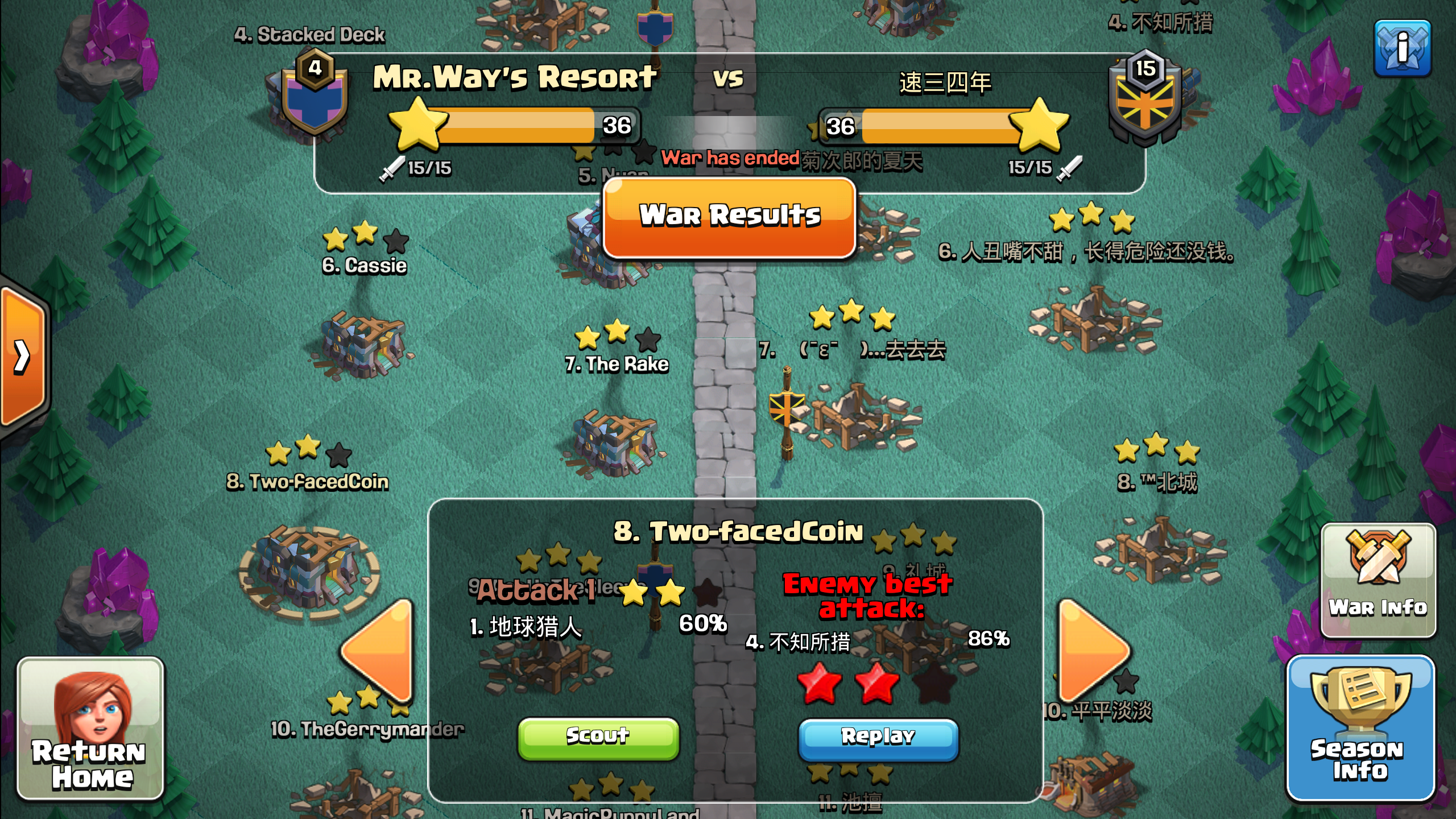 Every time your #1 can?t 3-star their #1 anyway, it?s best for somebody weaker to handle it. Same for #2, #3, etc.
Every time your #1 can?t 3-star their #1 anyway, it?s best for somebody weaker to handle it. Same for #2, #3, etc.
There is one final way that you can improve your team?s overall likelihood of advancement, although it?s really just a minor aside. If you believe you are up against one of the two most relevant clans, it is more important to win the war than to earn stars. That is, maybe you have a very high level base with a poorly skilled player, so they will only get 1 star, and the enemy will only get 1 star, too. This is the best time to put in those players instead of your highly skilled, low-base players! Limiting the enemy and limiting yourself is better than giving away stars and maybe not getting them back.
This is only beneficial against teams that you are specifically trying to outrank; doing this against the #3 clan just boosts #1 and #2 against both of you. Only consider this as a possibility for the two relevant enemy teams. (either 6 & 7 or 1 & 2, depending which direction you?re out of your league). Also, of course, you will use your hero and power potions against these two most relevant ones.
This brings us to the next section: Identifying true rankings. CWL is sometimes awful, sometimes wonderful because:
 Admit it! We?ve all been this clan before. We?ve also been that #1 and #2!
Admit it! We?ve all been this clan before. We?ve also been that #1 and #2!
If you want to see who is your true competition, you need to figure out the true rankings. So, you?ll need to determine which clans have the best attacks and which clans have the best defenses, and see how each is doing given what they?ve already faced. There is uncertainty here because of randomness of individual performance as well as variable clan attack strategies and different players being put on the roster, but usually it?s pretty clear.
The way you do this is to compare how different clans each did against the same other clan. You may make inferences based on reasoning. Consider the following example:
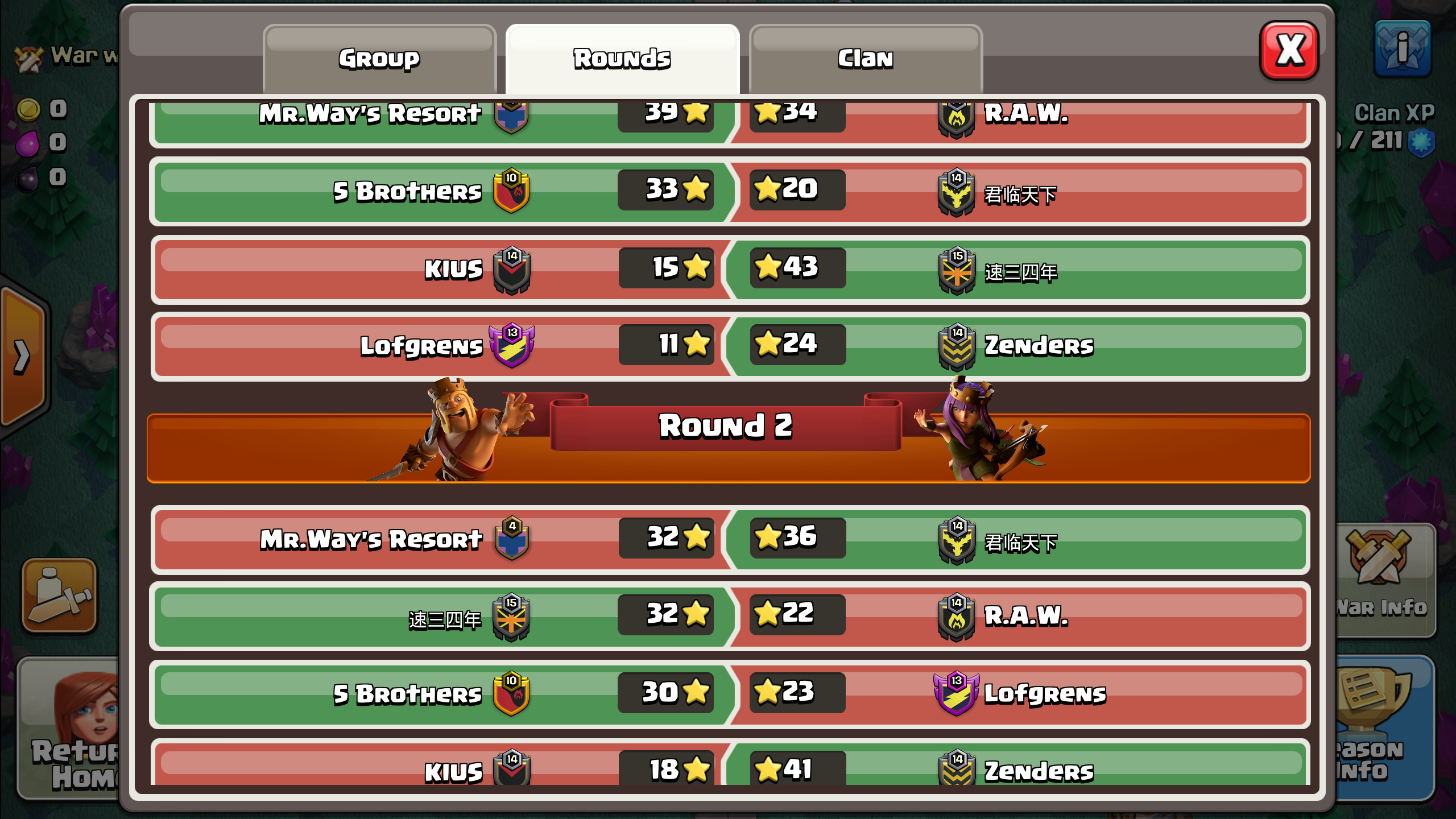
After round 1, you might think that orange icon team is #1.
However, with round 2, you see that Zenders got 41 against Kius and only 24 against lofgrens, and Orange Icon team only got 32 against R.A.W., whereas I got 39, so put these together and it means Kius just has really weak defenses.
Meanwhile, you can see that Orange Icon team only got 32 against R.A.W. whereas I got 39, so I will probably beat Orange Icon team when I get to them. I should probably get 43?45 against Kius!
Everyone does badly against Lofgrens, and Lofgrens does poorly against everyone. They probably have high level, inactive or noob bases.
Meanwhile, 5 Brothers did better against Yellow Icon clan than I did, and Yellow Icon beat me (although my dumbass forgot to put in castle defenses?), so 5 Brothers will be a very challenging clan, probably the #1.
Zenders did worse against Lofgrens than 5 brothers did, and worse against Kius than Orange Icon did, so they are likely going to go down for when they face harder match-ups.
R.A.W. and Yellow Icon had some of the hardest match-ups in their first two rounds, so they will probably rise from where they are, while Zenders and Orange Icon had the easiest matches, and so will probably fall.
My clan will contend for the #2 or #3 slot, most likely, because I forgot defenses and lost to yellow icon clan.
Lofgrens and Kius will compete for the #8 slot.

Thus, I estimate that the final rankings are likely to be rearranged in this order:2.4.5.1.6.3.7.8.
As you can see, the expected final rankings are much different from the early totals, although the clear losers are probably easy to determine right away.
This example was coincidentally really good. It is not usually until the end of round 3 that you can have real confidence about which two clans are your main competition. Even then, it?s possible for surprises.
And, as a final reminder, when you are against those two most relevant clans, you should be using power potions, hero potions, and possibly your strong defensive players who are weak on offense.
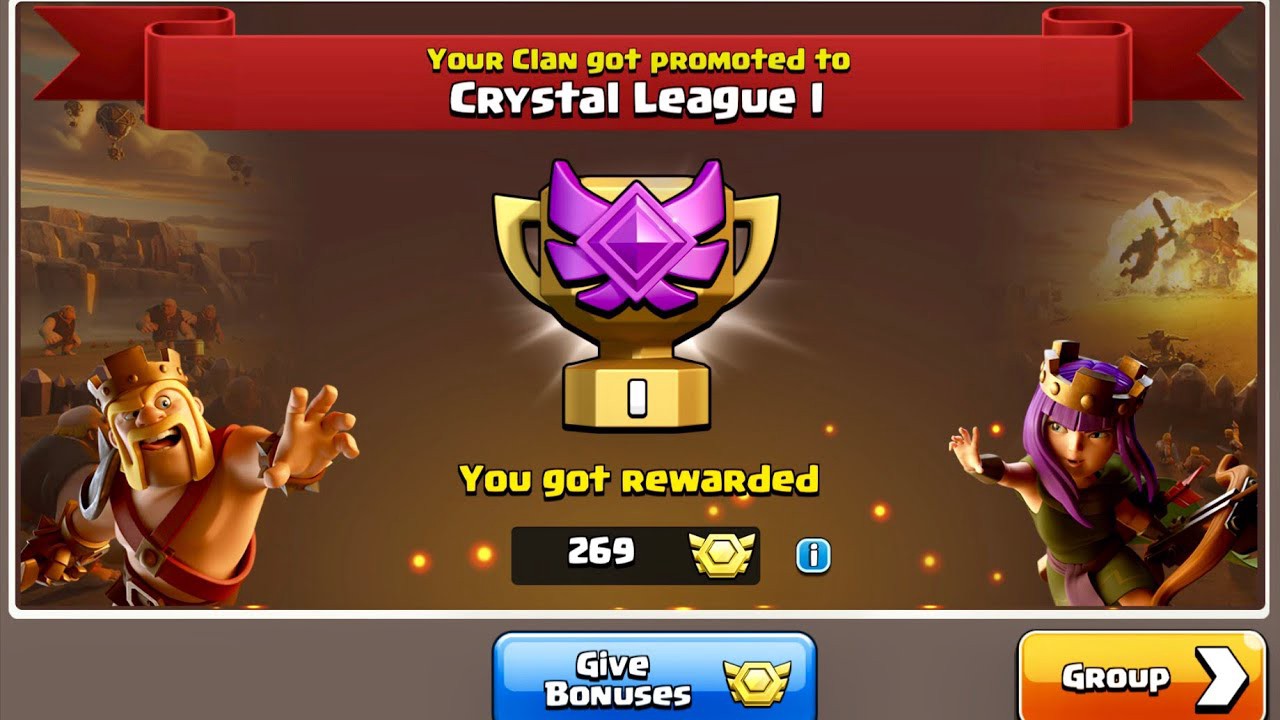 Congratulations on finishing section I! I hope all that advice helps you to advance your war league rank!
Congratulations on finishing section I! I hope all that advice helps you to advance your war league rank!
Section II: Optimizing Clan Rewards
Alright, now that we have talked about how to optimize your chance of winning (which is surprisingly complex, eh?) we need to add another dimension of complexity as we describe this next set of concepts.
Basically, once you have risen to as high a league as your clan can sustain, it is no longer a question of how to advance, but just how not to drop a league. And, the difference between, say, 3rd place and 6th place is actually quite marginal.
Meanwhile, it is very likely that you have some clan members who are being left out, since you would need exactly 15 or exactly 30 participants to avoid that. For a clan member to receive the full benefits from the event, they need to participate in at least three of the wars.
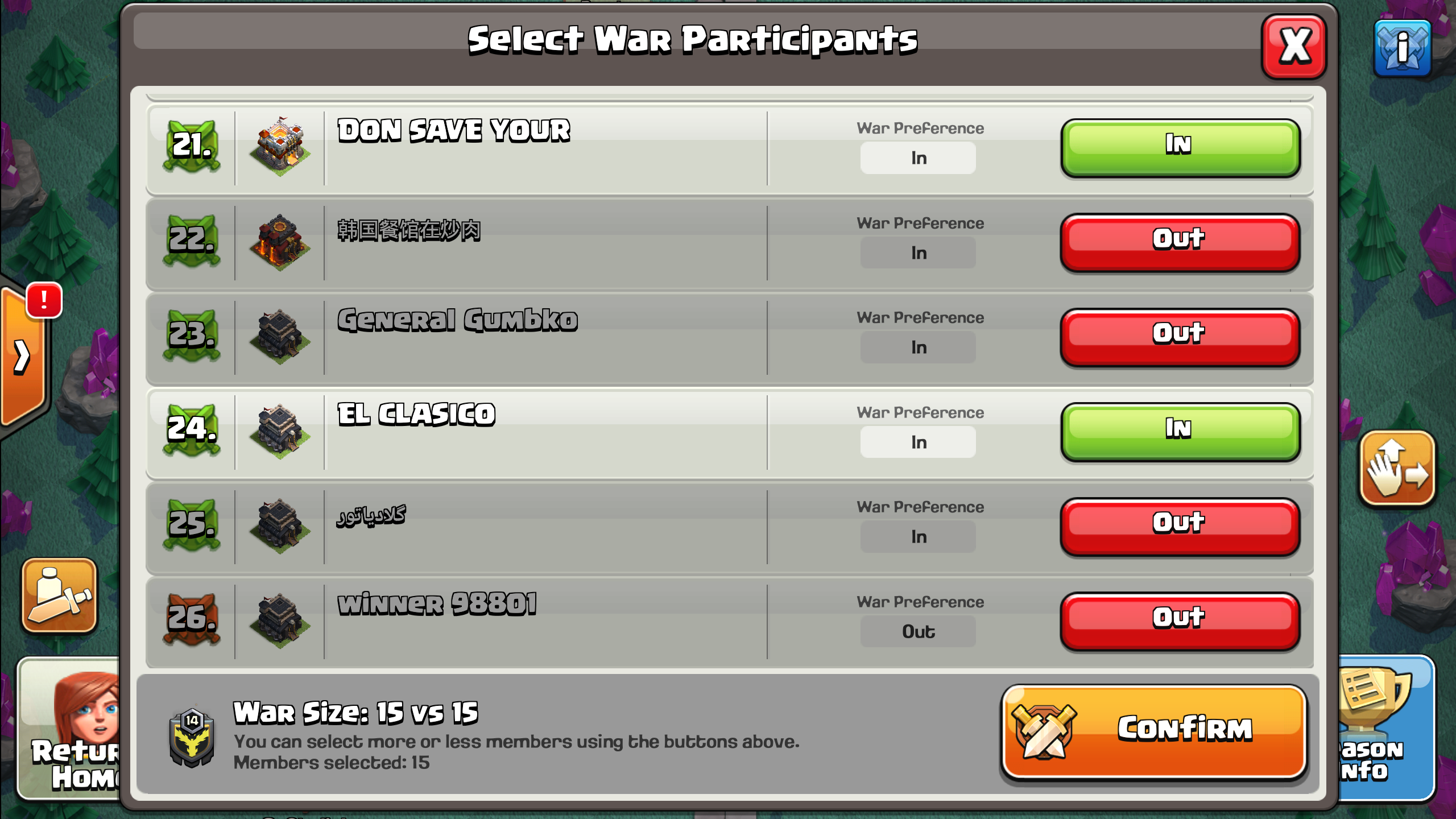 <Sigh> This never feels good, but I am leaving some of you marked ?in? out of this war.
<Sigh> This never feels good, but I am leaving some of you marked ?in? out of this war.
This creates an obvious conflict. You want to bring your top 15 or your top 30, but you also want to give your weaker members a chance to get the full rewards. How can you figure out the right balance between inclusion and competition to maximize the benefit for the clan as a whole?
We will now examine the best way to approach the inclusion of weaker members, minimizing the loss to your clan?s competitiveness in that league.
There are three situations, and how you should act depends on which best fits your clan. We will discuss all three. Note that these categories overlap into each other, and therefore the strategies must be interpreted as points on a scale rather than discrete categories.
i. You have a real chance to compete for the promotion slot(s),
ii. You are comfortably in the middle of the pack,
iii. You are fighting for your life at the bottom!
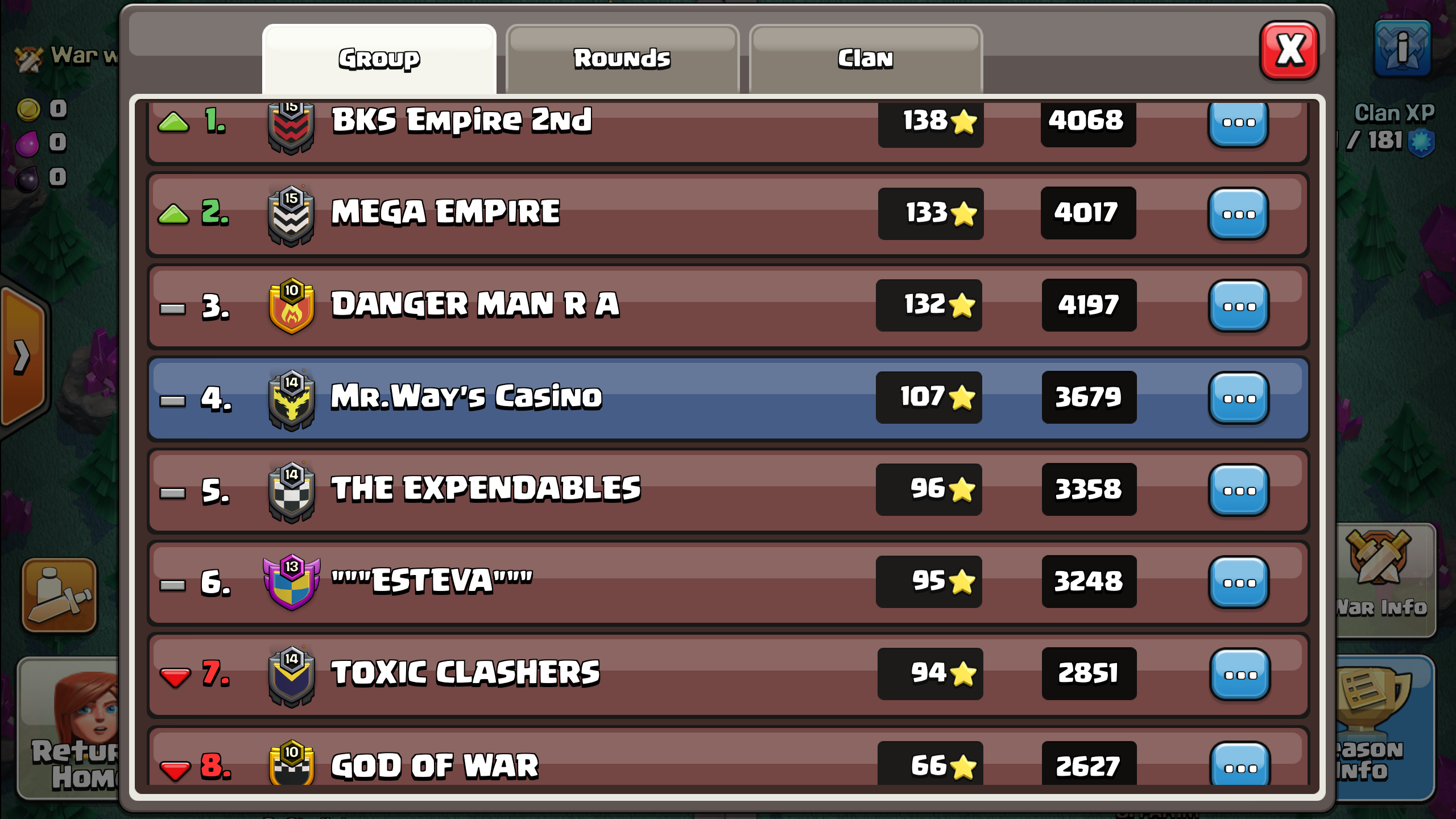 Clans 1, 2, and 3 are all contending for promotion. Clans 5, 6, 7 are all at risk of being demoted. My clan is pretty securely in the middle. Clan 8 is pretty much guaranteed to be demoted.
Clans 1, 2, and 3 are all contending for promotion. Clans 5, 6, 7 are all at risk of being demoted. My clan is pretty securely in the middle. Clan 8 is pretty much guaranteed to be demoted.
When deciding how you?ll distribute your clan members, first you will divide up your clan into three groups: A Team, B team, and C team.
A Team will have X members, B Team and C Team each have Y members.
Y = (# of participants) – (15) or minus 30 if you?re doing 30v30
X = 15 – Y; or 30 – Y
Example One: if you have 24 clan members who want to play, you can only bring 15 at a time.
Your B and C teams are therefore 24 ? 15= 9 middle and 9 lowest players.Your A Team is therefore 15 ? 9 = 6 highest players.
You will always bring your A Team, and you will use B Team in ?important? wars. You will use C Team in a maximum of four wars that are ?not important?
Example Two: You have 43 clan members who want to play, and you can only bring 30 at a time.
Your B and C Teams are therefore 43 – 30 = 13 middle and 13 lowest players.Your A Team is 30 ? 13 = 17 top players.
You will always bring your 17 A Team members, and you will swap out your 13 B team members for some or all of the 13 C Team members in the ?less important? wars. Ideally you will have 4 or more ?not important? wars for C Team to participate in.
In extreme cases, it might even be possible to swap out A team members with C Team members without losing many stars for the clan. This dramatically increases participation and probability of 8 stars for everybody, but if you are overconfident, you can easily lose an easy war by surprise and drop much more than you expected.
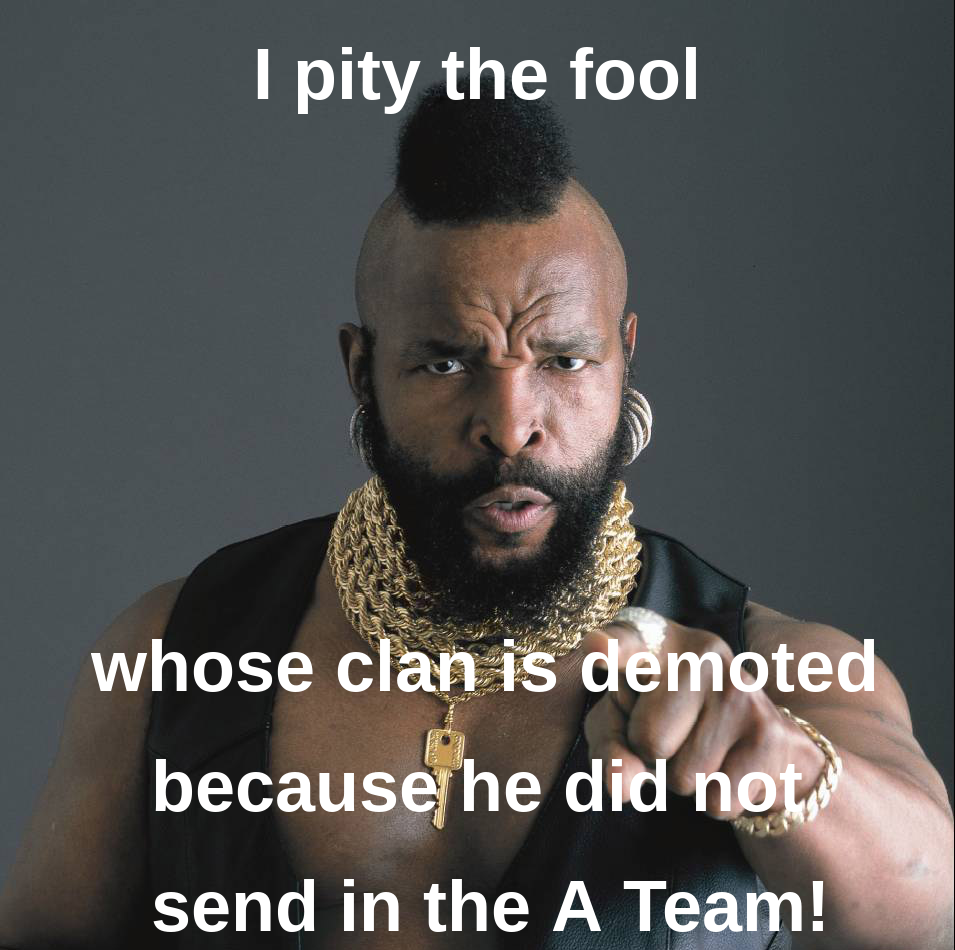
Okay, the three scenarios:
(i) If you believe your clan is contending for promotion, you will want to run your A team and B team exclusively until you are absolutely certain that nobody can catch up to you, or you find out you are not in the running. This will likely the end of the 4th round or later; however, you may also still need to use your best lineup for the #1 and #2 clans if they are in the last group.
When you are seeking promotion, you may have to sacrifice the participation of your weaker members. Only if you are very, very far ahead of every clan but #1, or very sure that the coming opponent will have weak defenses that even your C team can handle, only in those situations should you take a lot of chances with weak clan mates. You might consider cycling in only the top of C team for the Bottom of B team in the lower wars if you?re not extremely confident.
(ii) This is best for encouraging full participation. If your clan is in the middle of the pack, (like, you already can see the two clans that will beat you for sure by true rankings), then you want to focus your energy on defeating the #3 and #4 clans and maybe #5, to secure a little bit more league points. The rest of the wars between clans 1, 2, 6, and 7 are not as important, and you can replace anywhere from ??one? to ?all? of your lowest B Team members with your highest C Team members that still need to get to 8 stars. As a general rule, you will never replace your A team. Note, your C team will probably struggle to earn stars against the #1 and #2 clans, so 5, 6, and 7 are really going to be their main opportunities.
 If all the attacks are done this round, it?s a perfect example of a great opportunity to include our C team in the rest of the wars. Clearly 1, 2, and 3 are going to beat us, and we?re way too far ahead of 7 and 8 to get demoted.
If all the attacks are done this round, it?s a perfect example of a great opportunity to include our C team in the rest of the wars. Clearly 1, 2, and 3 are going to beat us, and we?re way too far ahead of 7 and 8 to get demoted.
(iii) If your clan is near the bottom, you might not want to include your lower members at all. For sure, not until you are completely certain that you have outranked at least two clans by beating them directly and outperforming them indirectly as well. Remember to use true rankings, or else you might make poor roster decisions that cost you your place in the league. And remember! Other clans may have been sandbagging their early rounds with weak members. Wait until you actually beat them before you assume you will beat them, unless it?s a huge indirectly implied margin of victory for you.
Alright, that?s all good in theory, but as you recall from earlier, you are not going to know your true rankings until you get to the end of round 2, and probably really not until the end of round 3.
Also, sometimes, like in the above example, the #1 and #2 and #3 enemies are so close that if you beat #1 and #2 but lose to #3, #3 would likely take the lead. If there is a cluster of scores like that, all of those clans become ?important? for your ranking. Interpret these rules with this knowledge in mind.
So, you will not know for certain whether you are in situation (i), (ii), or (iii) and what true rank each opponent is until you have already faced at least two other clans. Therefore, for those first two wars, you must always bring your A and B teams exclusively, just in case one of those matches ended up being one of the two critical ones for you to be promoted. Only after you have been able to determine true rankings can you begin to include C Team members with confidence that you are not threatening your clan?s league status.
By the time you recognize that you are in situation (ii), there might not be enough easy wars left for your lower guys to get to 8 stars. Oh well! They should level up their attacks fast! It?s not hard to do, even Free-To-Play.
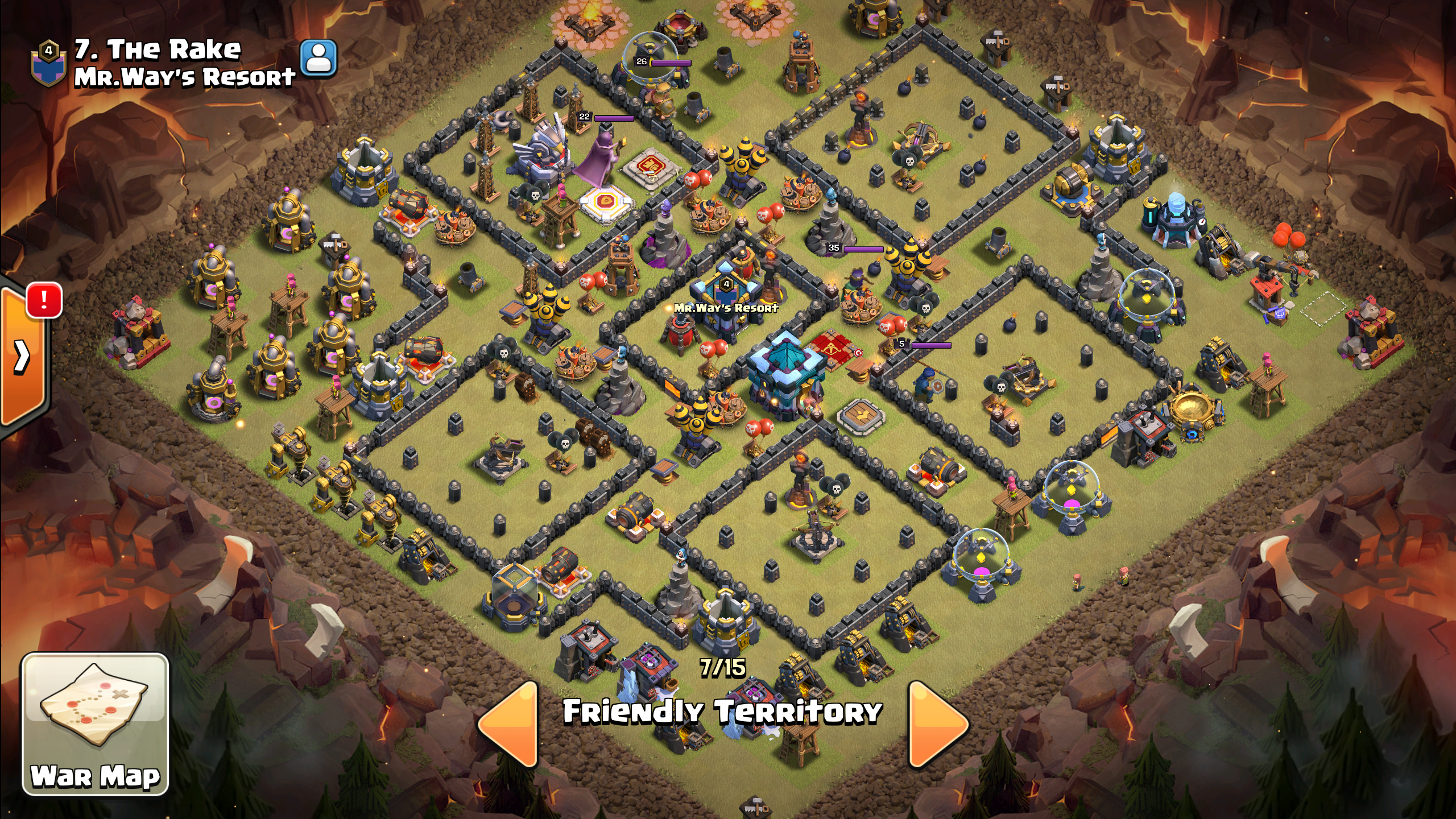 A War Blitz base doesn?t need to look Noob-Rushed. The primary question is their attack power, not defense.
A War Blitz base doesn?t need to look Noob-Rushed. The primary question is their attack power, not defense.
If you are not unlucky, you will face one of the critical opponents during those first two wars, and if you beat them, that will make lots of room to use your lowest players later. If you develop a big lead over the true #1 and #2 (or #6 and #7, or #3 and #4 or whatever) opponents early on, you can likely include all of C Team until they get 8 stars each.
However, if you can see that it?s going to be close between you landing between #2 and #3 or between #6 and #7, you should not include C Team members at all. Not at all! Not unless you can count on them to get 3 stars in that match just as much as you could count on your B team.
I?ve mentioned this a couple of times, but just to re-emphasize: you should only replace as much of your B team as you feel will not compromise your chances of ranking in the set you?re aiming for, whether that?s #3 to #6 or #1 to #2. If that means you only swap out the bottom slot out of 30, so be it. Do what is best in the long run for the collective, not the individual. Those who cannot accept this should be welcome to depart.
~ ~ ~ ~ ~
A final note before we conclude: in between CWL, it is important to focus on maximizing the attack power of your B and C teams, and maximizing the defensive power of your A team.
For B and C teams, this will probably mean rushing their town halls as soon as they get their army camps, castle, and favorite troops maxed out so that they can unlock higher levels and new heroes. To remain competitive in normal war, it is advisable that they save up hammers and points to rush instantly into 2 capped out troops and 2 capped out spells as soon as they reach a new TH level, or time it to get everything done just in time to benefit for CWL.
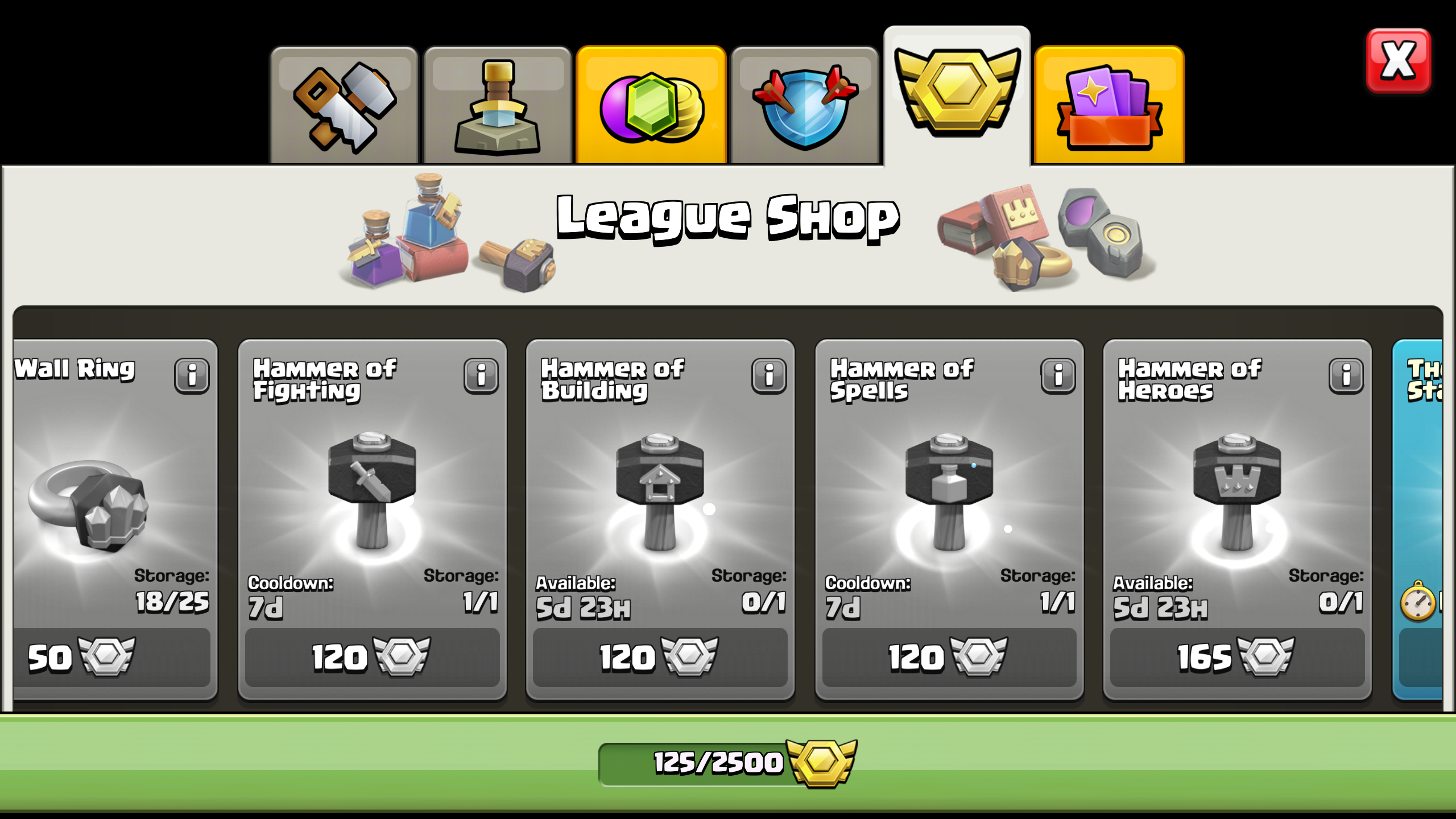 When upgrading your TH, you should ideally have 2 hammers of fighting instantly available and, depending what TH level, 1?2 hammers of spells and a hammer of building as well.
When upgrading your TH, you should ideally have 2 hammers of fighting instantly available and, depending what TH level, 1?2 hammers of spells and a hammer of building as well.
For A Team, improving will mean more of what they have probably already been doing, which is to cap out their towers. They started a long time ago, so they now have very powerful defenses and attacks. Probably the limiting factor is heroes, and they will likely get the most value out of hero hammers, although hammers of building are also a possibility.
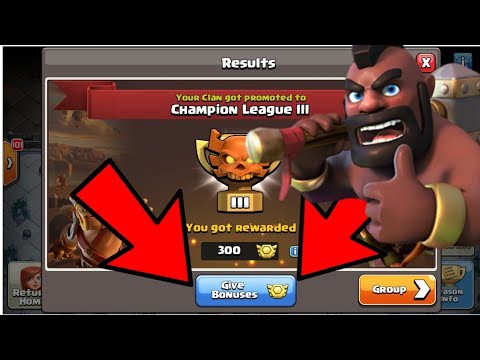 So uh? who should get the bonuses?
So uh? who should get the bonuses?
If you want to do what is best for the clan?s long-term advancement, then you should distribute the bonuses among those closest to having maxed out defenses. Hammers will do the most for them, after all.
However, if you need to bring your lower players up more to have them even be useful for 2-star swaps on a regular basis, then it is probably better to invest in your B team so that they can rapidly advance toward TH13 war blitz bases.
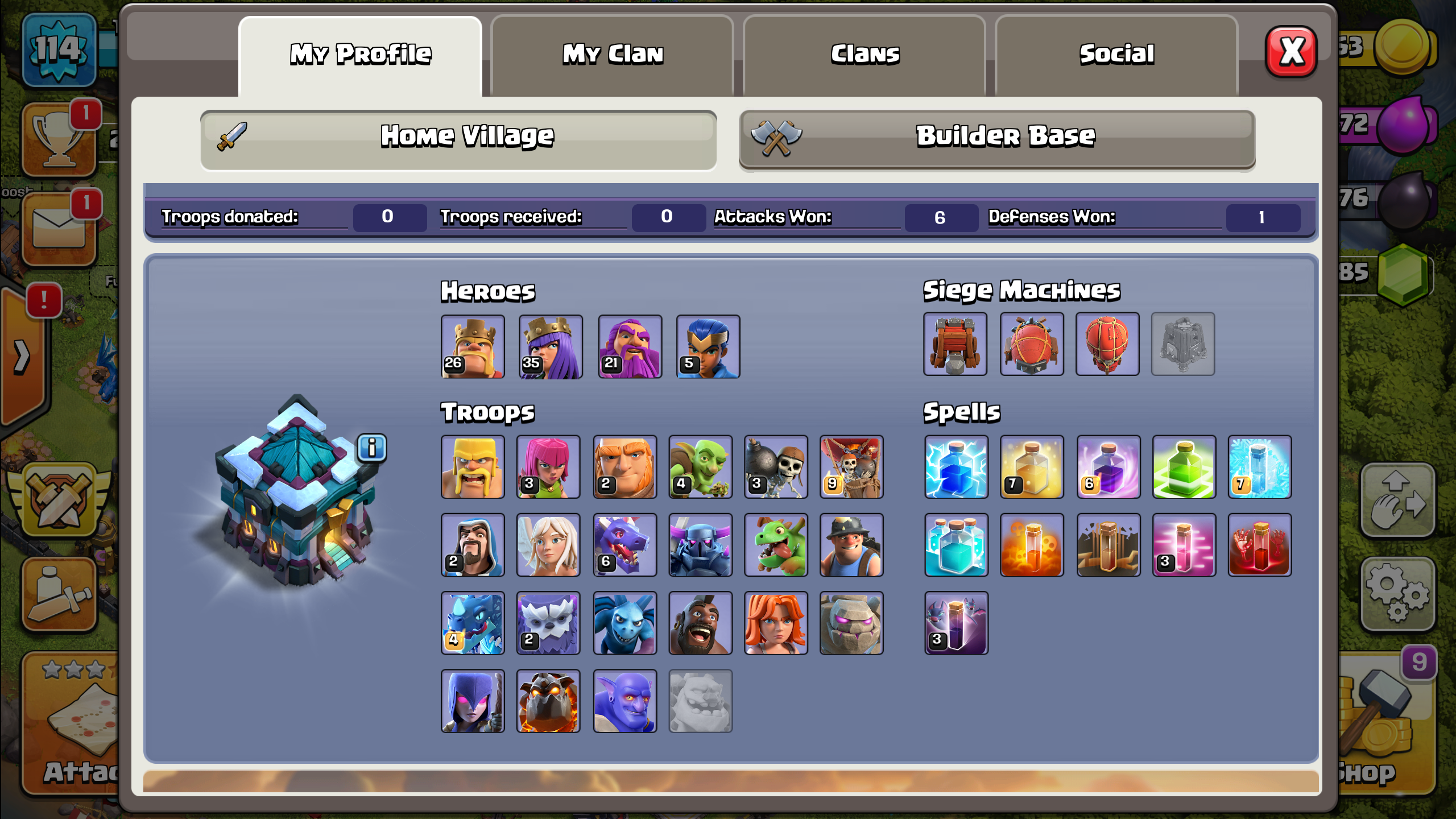 Your whole B team should have (E)drag/loon/freeze/rage or miner/heal maxed out, and 280 army, 45 castle.
Your whole B team should have (E)drag/loon/freeze/rage or miner/heal maxed out, and 280 army, 45 castle.
You should not invest in your C team. They will need to demonstrate that they are the best attackers, and graduate to the B Team or even the A Team, before they are considered for bonuses.
There may be other ways that you want to distribute bonuses. Perhaps you will distribute these bonuses for those who earned the most CWL stars per war, or got 4000 clan games points, or those who donated the most units, or things like this. Those also make sense for other priorities, but they will not help you as much to advance further in CWL, which would ultimately result in more league points for everybody.
And, with one final note of how to practice in between CWL seasons, it will also be good for clan members to practice attacking higher and lower in war, as well as practicing 3-star gambits at their own level and 2-star gambits far above themselves, to maximize the synergy possible during the more restrictive clan war league setting. During regular war, everyone can use one ?safe? attack and one ?gambit? and every base should be covered very well. Plus they will get practice with safe attacks and gambits.
You?ll find that some players are better at some kinds of gambits. Like, some will be great at 3-starring at their own level, others will be great at 2-starring far above themselves, the occasional superstar will be decent at 3-starring above their own level!
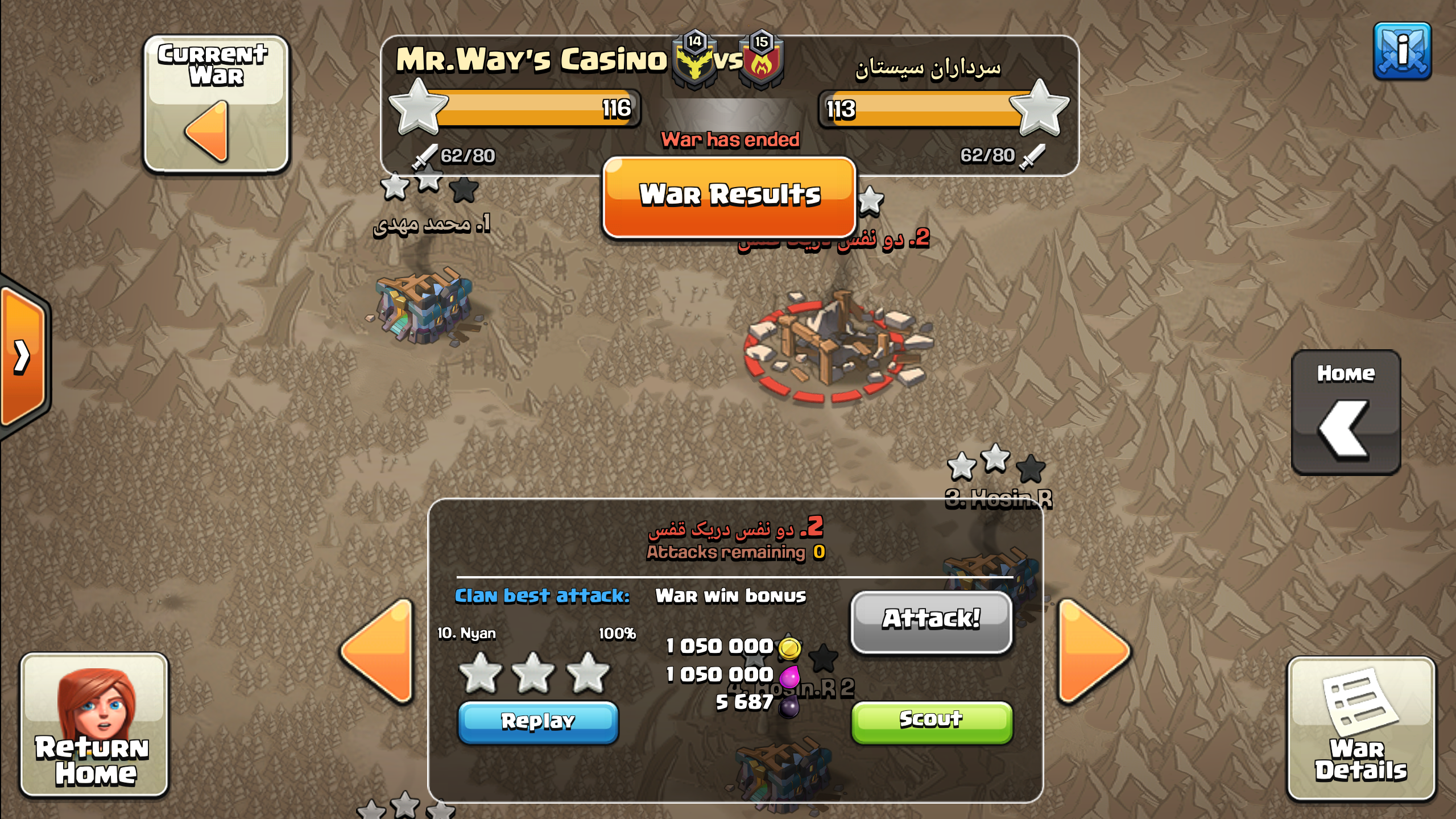 Practice enough gambits and you?ll start to see these kinds of results regularly. When you can count on 2-star gambits from a lot of your team, your CWL strategies can become very advanced.
Practice enough gambits and you?ll start to see these kinds of results regularly. When you can count on 2-star gambits from a lot of your team, your CWL strategies can become very advanced.
Congratulations on making it to the end! Or, if you just read the pictures on the way, that?s cool, too. I tried to put most of the important ideas there with them. I hope you find this guide useful for understanding and responding optimally to the deceptively simple-looking, multi-layered complexity of Clan War League and CWL point maximization!
If you want to share this with your clan in-game, here is a short URL that anybody can type in manually. It has the friend link to this same page!
shorturl.at/ejEMU
If you liked this article and would like to read more of my analysis and theory about this game, check out and follow Mr. Way?s School of Clash!

